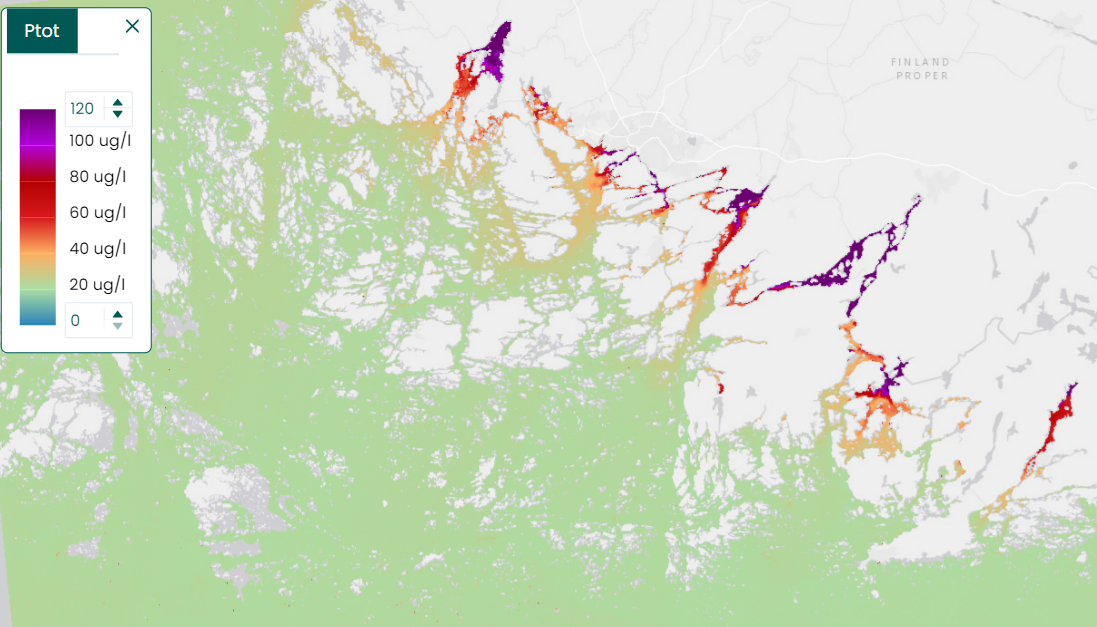[FI] Satelliittihavainnoista havaittu kokonaisfosfori toimii täydentävä tekijänä Suomen rannikkovesien ekologisessa luokittelussa vesipuitedirektiivin (VPD) mukaisesti, erityisesti kun maastomittauksista saatu data on riittämätöntä. Saaristomeren fosforikartat [µg/l] kuvaavat joesta tulevan fosforin määrää. Yhtenäisessä muodossa tulkitut kartat kattavat vuodet 2018 – 2022. Aineistot koostuvat kevään fosforin maksimikartoista (1.-31.5.) ja kesän (17.5.-30.9) fosforin keskiarvokartoista.
Fosforiaineisto on laskettu päivittäisten sameushavaintojen kevätmaksimista ja kesäajan keskiarvosta. Kevätajan sameushavaintojen maksimi ja kesäajan sameushavaintojen keskiarvo on muunnettu arvioksi kokonaisfosforin määrästä käyttäen Saaristomeren rannikkovesille sovitettua muunnoskerrointa sameuden ja fosforin välillä (yhtälö: Kari Kallio, Ptot = 1.82*sameus + 20.13). Sameusarvot on laskettu käyttämällä Sentinel-2 MSI ja Landsat-8 OLI -instrumenttien havaintoja. Satelliittidata on käsitelty sameusarvoiksi käyttämällä C2RCC (Case 2 Regional Coast Colour) -vedenlaatuprosessoria, mutta prosessorin takaisinsirontaa kuvaava lopputulos on muunnettu vastaamaan Suomen rannikkovesien olosuhteita. Kesäajan keskiarvoaineistosta on poistettu sinilevään liittyvät havainnot.
Aineiston maastoerotuskyky on 60 metriä.
Aineisto kuuluu Syken avoimiin aineistoihin (CC BY 4.0).
[EN] Total phosphorus obtained via Earth Observation serves as a complementary factor in the ecological classification of Finnish coastal water bodies for the Water Framework Directive (WFD), gaining prominence when in-situ measurement data is insufficient. Phosphorus maps of the Archipelago Sea describe the amount of total phosphorus [µg/l] transported from the drainage basin. The maps are interpreted in a unified format to cover the years 2018 - 2022. The data consists of the maximum total phosphorus maps of springtime (from May 1st to May 31st) and the average total phosphorus maps of summer (from May 17th to September 30th).
The phosphorus data is based on a composite of daily turbidity observations. Total phosphorus was calculated by aggregating daily estimates of turbidity derived from satellite observations for the given period (spring and summer). The conversion was performed by using an adapted conversion equation for the coastal waters of the Archipelago Sea, based on the relationship between turbidity and total phosphorus (equation by Kari Kallio, Ptot = 1.82*turbidity +20.13). Turbidity values have been calculated by using observations from the Sentinel-2 MSI and Landsat-8 OLI instruments. The processing of the satellite data to turbidity values was done by using the C2RCC (Case 2 Regional Coast Color) water quality processor. The backscattering estimated by the processor has been modified to reflect the conditions of Finnish coastal waters. The observations of the blue-green algae period have been removed from the data.
The spatial resolution of the data is 60 meters.
The dataset follows Syke’s open data policy (CC BY 4.0).
WMS-palvelin/ WMS service endpoint: https://geoserver2.ymparisto.fi/geoserver/eo/wms
WMS-taso kevätajan maksimiaineistoille/ WMS layer for the srping time maximum data:
eo:EO_HR_S2_LC8_PTOT_MAX_season
WMS-taso kesän keskiarvoaineistoille/ WMS layer for the summer mean data:
eo:EO_HR_S2_LC8_PTOT_MEAN_season

